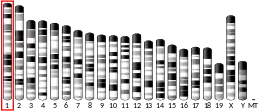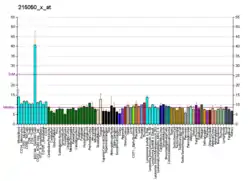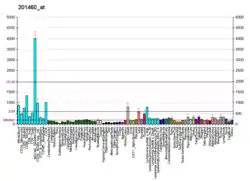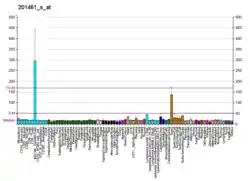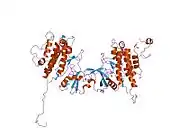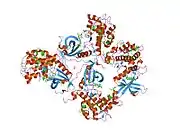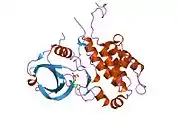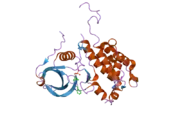MAPKAPK2
MAP kinase-activated protein kinase 2 is an enzyme that in humans is encoded by the MAPKAPK2 gene.[5][6]
Function
This gene encodes a member of the Ser/Thr protein kinase family. This kinase is regulated through direct phosphorylation by p38 MAP kinase. In conjunction with p38 MAP kinase, this kinase is known to be involved in many cellular processes including stress and inflammatory responses, nuclear export, gene expression regulation and cell proliferation. Heat shock protein HSP27 was shown to be one of the substrates of this kinase in vivo. Two transcript variants encoding two different isoforms have been found for this gene.[7]
SASP initiation
MAPKAPK2 mediates the initiation of the senescence-associated secretory phenotype (SASP) by mTOR (mechanistic target of rapamycin).[8][9] Interleukin 1 alpha (IL1A) is found on the surface of senescent cells, where it contributes to the production of SASP factors due to a positive feedback loop with NF-κB.[10][11] Translation of mRNA for IL1A is highly dependent upon mTOR activity.[12] mTOR activity increases levels of IL1A, mediated by MAPKAPK2.[10]
See also
- SB 203580, suppresses the activation of MAPKAPK2
Interactions
MAPKAPK2 has been shown to interact with:
References
- GRCh38: Ensembl release 89: ENSG00000162889 - Ensembl, May 2017
- GRCm38: Ensembl release 89: ENSMUSG00000016528 - Ensembl, May 2017
- "Human PubMed Reference:". National Center for Biotechnology Information, U.S. National Library of Medicine.
- "Mouse PubMed Reference:". National Center for Biotechnology Information, U.S. National Library of Medicine.
- Zu YL, Wu F, Gilchrist A, Ai Y, Labadia ME, Huang CK (Jun 1994). "The primary structure of a human MAP kinase activated protein kinase 2". Biochem Biophys Res Commun. 200 (2): 1118–24. doi:10.1006/bbrc.1994.1566. PMID 8179591.
- Stokoe D, Caudwell B, Cohen PT, Cohen P (Feb 1994). "The substrate specificity and structure of mitogen-activated protein (MAP) kinase-activated protein kinase-2". Biochem J. 296 (Pt 3): 843–9. doi:10.1042/bj2960843. PMC 1137771. PMID 8280084.
- "Entrez Gene: MAPKAPK2 mitogen-activated protein kinase-activated protein kinase 2".
- Yessenkyzy A, Saliev T, Zhanaliyeva M, Nurgozhin T (2020). "Polyphenols as Caloric-Restriction Mimetics and Autophagy Inducers in Aging Research". Nutrients. 12 (5): 1344. doi:10.3390/nu12051344. PMC 7285205. PMID 32397145.
- Papadopoli D, Boulay K, Kazak L, Hulea L (2019). "mTOR as a central regulator of lifespan and aging". F1000Research. 8: 998. doi:10.12688/f1000research.17196.1. PMC 6611156. PMID 31316753.
- Laberge R, Sun Y, Orjalo AV, Patil CK, Campisi J (2015). "MTOR regulates the pro-tumorigenic senescence-associated secretory phenotype by promoting IL1A translation". Nature Cell Biology. 17 (8): 1049–1061. doi:10.1038/ncb3195. PMC 4691706. PMID 26147250.
- Wang R, Yu Z, Sunchu B, Perez VI (2017). "Rapamycin inhibits the secretory phenotype of senescent cells by a Nrf2-independent mechanism". Aging Cell. 16 (3): 564–574. doi:10.1111/acel.12587. PMC 5418203. PMID 28371119.
- Wang R, Sunchu B, Perez VI (2017). "Rapamycin and the inhibition of the secretory phenotype". Experimental Gerontology. 94: 89–92. doi:10.1016/j.exger.2017.01.026. PMID 28167236. S2CID 4960885.
- Rane MJ, Coxon PY, Powell DW, Webster R, Klein JB, Pierce W, Ping P, McLeish KR (Feb 2001). "p38 Kinase-dependent MAPKAPK-2 activation functions as 3-phosphoinositide-dependent kinase-2 for Akt in human neutrophils". J. Biol. Chem. 276 (5): 3517–23. doi:10.1074/jbc.M005953200. PMID 11042204.
- Janknecht R (Nov 2001). "Cell type-specific inhibition of the ETS transcription factor ER81 by mitogen-activated protein kinase-activated protein kinase 2". J. Biol. Chem. 276 (45): 41856–61. doi:10.1074/jbc.M106630200. PMID 11551945.
- Yannoni YM, Gaestel M, Lin LL (Apr 2004). "P66(ShcA) interacts with MAPKAP kinase 2 and regulates its activity". FEBS Lett. 564 (1–2): 205–11. doi:10.1016/S0014-5793(04)00351-5. PMID 15094067.
- Dondelinger Y, Delanghe T, Rojas-Rivera D, Priem D, Delvaeye T, Bruggeman I, Van Herreweghe F, Vandenabeele P, Bertrand MJ (October 2017). "MK2 phosphorylation of RIPK1 regulates TNF-mediated cell death". Nature Cell Biology. 19 (10): 1237–1247. doi:10.1038/ncb3608. PMID 28920952. S2CID 25779284.
Further reading
- Kapopara PR, von Felden J, Soehnlein O, Wang Y, Napp LC, Sonnenschein K, Wollert KC, Schieffer B, Gaestel M, Bauersachs J, Bavendiek U (2014). "Deficiency of MAPK-activated protein kinase 2 (MK2) prevents adverse remodelling and promotes endothelial healing after arterial injury". Thromb. Haemost. 112 (6): 1–13. doi:10.1160/TH14-02-0174. PMID 25120198.
- Ben-Levy R, Hooper S, Wilson R, Paterson HF, Marshall CJ (1999). "Nuclear export of the stress-activated protein kinase p38 mediated by its substrate MAPKAP kinase-2". Curr. Biol. 8 (19): 1049–57. doi:10.1016/S0960-9822(98)70442-7. PMID 9768359. S2CID 15627349.
- Stokoe D, Engel K, Campbell DG, Cohen P, Gaestel M (1992). "Identification of MAPKAP kinase 2 as a major enzyme responsible for the phosphorylation of the small mammalian heat shock proteins". FEBS Lett. 313 (3): 307–13. doi:10.1016/0014-5793(92)81216-9. PMID 1332886.
- Vulliet PR, Woodgett JR, Cohen P (1984). "Phosphorylation of tyrosine hydroxylase by calmodulin-dependent multiprotein kinase". J. Biol. Chem. 259 (22): 13680–3. doi:10.1016/S0021-9258(18)89798-8. PMID 6150037.
- Engel K, Schultz H, Martin F, Kotlyarov A, Plath K, Hahn M, Heinemann U, Gaestel M (1995). "Constitutive activation of mitogen-activated protein kinase-activated protein kinase 2 by mutation of phosphorylation sites and an A-helix motif". J. Biol. Chem. 270 (45): 27213–21. doi:10.1074/jbc.270.45.27213. PMID 7592979.
- Lavoie JN, Lambert H, Hickey E, Weber LA, Landry J (1995). "Modulation of cellular thermoresistance and actin filament stability accompanies phosphorylation-induced changes in the oligomeric structure of heat shock protein 27". Mol. Cell. Biol. 15 (1): 505–16. doi:10.1128/MCB.15.1.505. PMC 232001. PMID 7799959.
- Sutherland C, Alterio J, Campbell DG, Le Bourdellès B, Mallet J, Haavik J, Cohen P (1993). "Phosphorylation and activation of human tyrosine hydroxylase in vitro by mitogen-activated protein (MAP) kinase and MAP-kinase-activated kinases 1 and 2". Eur. J. Biochem. 217 (2): 715–22. doi:10.1111/j.1432-1033.1993.tb18297.x. PMID 7901013.
- Knauf U, Jakob U, Engel K, Buchner J, Gaestel M (1994). "Stress- and mitogen-induced phosphorylation of the small heat shock protein Hsp25 by MAPKAP kinase 2 is not essential for chaperone properties and cellular thermoresistance". EMBO J. 13 (1): 54–60. doi:10.1002/j.1460-2075.1994.tb06234.x. PMC 394778. PMID 7905823.
- Freshney NW, Rawlinson L, Guesdon F, Jones E, Cowley S, Hsuan J, Saklatvala J (1994). "Interleukin-1 activates a novel protein kinase cascade that results in the phosphorylation of Hsp27". Cell. 78 (6): 1039–49. doi:10.1016/0092-8674(94)90278-X. PMID 7923354. S2CID 37608621.
- Rivera VM, Miranti CK, Misra RP, Ginty DD, Chen RH, Blenis J, Greenberg ME (1993). "A growth factor-induced kinase phosphorylates the serum response factor at a site that regulates its DNA-binding activity". Mol. Cell. Biol. 13 (10): 6260–73. doi:10.1128/mcb.13.10.6260. PMC 364685. PMID 8413226.
- Beyaert R, Cuenda A, Vanden Berghe W, Plaisance S, Lee JC, Haegeman G, Cohen P, Fiers W (1996). "The p38/RK mitogen-activated protein kinase pathway regulates interleukin-6 synthesis response to tumor necrosis factor". EMBO J. 15 (8): 1914–23. doi:10.1002/j.1460-2075.1996.tb00542.x. PMC 450110. PMID 8617238.
- Ben-Levy R, Leighton IA, Doza YN, Attwood P, Morrice N, Marshall CJ, Cohen P (1996). "Identification of novel phosphorylation sites required for activation of MAPKAP kinase-2". EMBO J. 14 (23): 5920–30. doi:10.1002/j.1460-2075.1995.tb00280.x. PMC 394711. PMID 8846784.
- Tan Y, Rouse J, Zhang A, Cariati S, Cohen P, Comb MJ (1997). "FGF and stress regulate CREB and ATF-1 via a pathway involving p38 MAP kinase and MAPKAP kinase-2". EMBO J. 15 (17): 4629–42. doi:10.1002/j.1460-2075.1996.tb00840.x. PMC 452194. PMID 8887554.
- Huang CK, Zhan L, Ai Y, Jongstra J (1997). "LSP1 is the major substrate for mitogen-activated protein kinase-activated protein kinase 2 in human neutrophils". J. Biol. Chem. 272 (1): 17–9. doi:10.1074/jbc.272.1.17. PMID 8995217.
- Krump E, Sanghera JS, Pelech SL, Furuya W, Grinstein S (1997). "Chemotactic peptide N-formyl-met-leu-phe activation of p38 mitogen-activated protein kinase (MAPK) and MAPK-activated protein kinase-2 in human neutrophils". J. Biol. Chem. 272 (2): 937–44. doi:10.1074/jbc.272.2.937. PMID 8995385.
- Engel K, Kotlyarov A, Gaestel M (1998). "Leptomycin B-sensitive nuclear export of MAPKAP kinase 2 is regulated by phosphorylation". EMBO J. 17 (12): 3363–71. doi:10.1093/emboj/17.12.3363. PMC 1170674. PMID 9628873.
- Craxton A, Shu G, Graves JD, Saklatvala J, Krebs EG, Clark EA (1998). "p38 MAPK is required for CD40-induced gene expression and proliferation in B lymphocytes". J. Immunol. 161 (7): 3225–36. PMID 9759836.
- Heidenreich O, Neininger A, Schratt G, Zinck R, Cahill MA, Engel K, Kotlyarov A, Kraft R, Kostka S, Gaestel M, Nordheim A (1999). "MAPKAP kinase 2 phosphorylates serum response factor in vitro and in vivo". J. Biol. Chem. 274 (20): 14434–43. doi:10.1074/jbc.274.20.14434. PMID 10318869.



